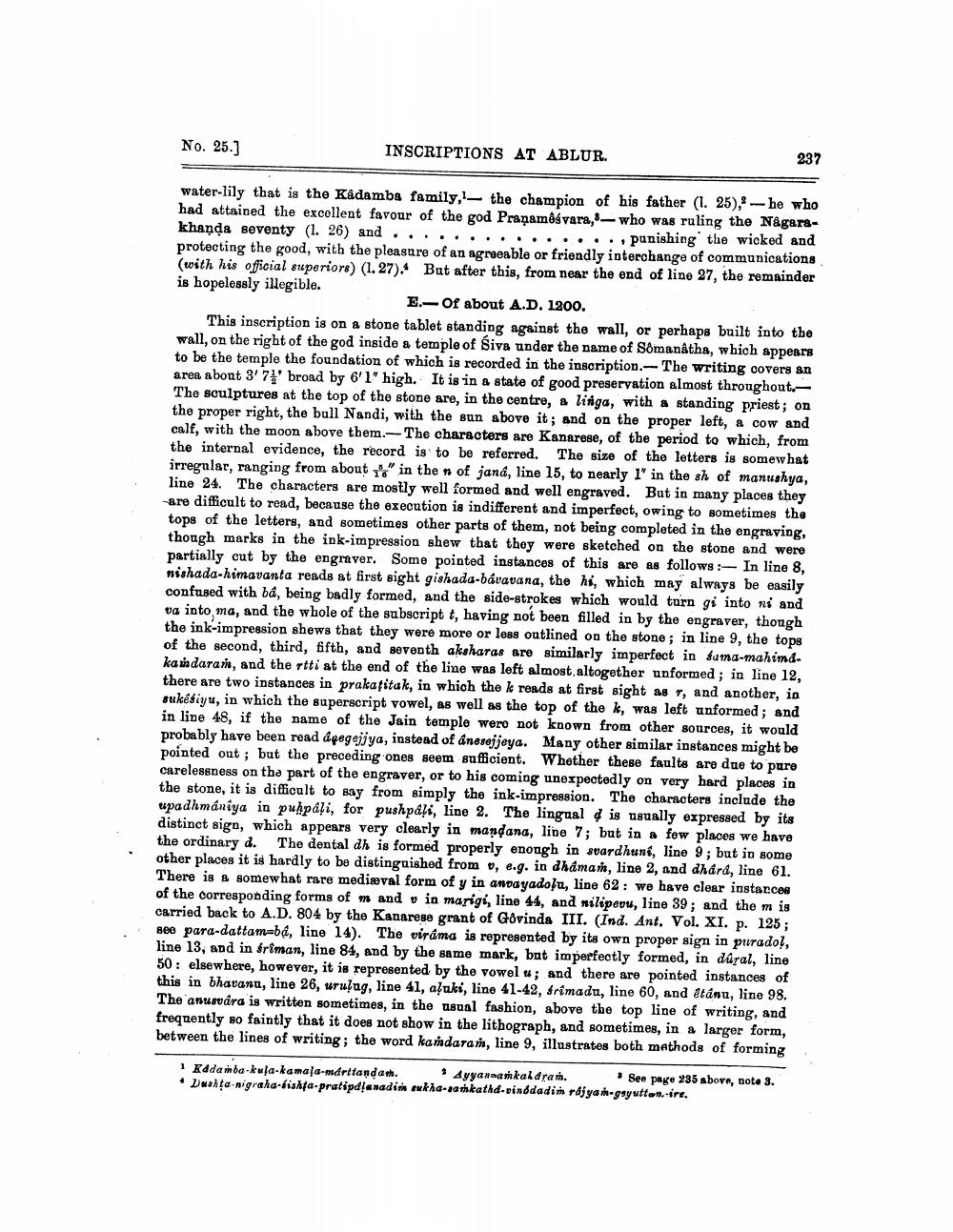________________
No. 25.]
INSCRIPTIONS AT ABLUR.
237
water-lily that is the Kadamba family, the champion of his father (1. 25), -he who had attained the excellent favour of the god Pranamêsvara, 8 — who was ruling the Någarakhanda seventy (1. 26) and ..............., punishing the wicked and protecting the good, with the pleasure of an agreeable or friendly interchange of communications (with his official superiors) (1.27). But after this, from near the end of line 27, the remainder is hopelessly illegible.
E.- of about A.D. 1200. This inscription is on a stone tablet standing against the wall, or perhaps built into the wall, on the right of the god inside a temple of Siva under the name of Sómanátha, which appears to be the temple the foundation of which is recorded in the inscription. The writing covers an area about 3' 71' broad by 6'1' high. It is in a state of good preservation almost throughout.The sculptures at the top of the stone are, in the centre, & litiga, with a standing priest; on the proper right, the bull Nandi, with the sun above it; and on the proper left, a cow and calf, with the moon above them.--The characters are Kanarese, of the period to which, from the internal evidence, the record is to be referred. The size of the letters is somewhat irregular, ranging from about 15" in the of jana, line 15, to nearly 1' in the sh of manushya, line 24. The characters are mostly well formed and well engraved. But in many places they are difficult to read, because the execution is indifferent and imperfect, owing to sometimes the tops of the letters, and sometimes other parts of them, not being completed in the engraving, though marks in the ink-impression shew that they were sketched on the stone and were partially cut by the engraver. Some pointed instances of this are as follows:- In line 8, nishada-himavanta reads at first sight gishada-bávavana, the hi, which may always be easily confused with ba, being badly formed, and the side-strokes which would turn gi into ni and va into ma, and the whole of the subscript t, having not been filled in by the engraver, though the ink-impression shews that they were more or less outlined on the stone ; in line 9, the tops of the second, third, fifth, and seventh aksharas are similarly imperfect in fuma-mahimakandaran, and the rtti at the end of the line was left almost altogether unformed ; in line 12, there are two instances in prakațitak, in which the k reads at first sight as r, and another, in sukesiyu, in which the superscript vowel, as well as the top of the k, was left unformed; and in line 48, if the name of the Jain temple were not known from other sources, it would probably have been read åpegeijya, instead of anesejjeya. Many other similar instances might be pointed out ; but the preceding ones seem sufficient. Whether these faults are due to pare carelessness on the part of the engraver, or to his coming unexpectedly on very hard places in the stone, it is difficult to say from simply the ink-impression. The characters include the upadhmaniya in puhpaļi, for pushpaļi, line 2. The lingual d is usually expressed by its distinct sign, which appears very clearly in mandana, line 7; but in a few places we have the ordinary d. The dental dh is formed properly enough in svardhuni, line 9; but in some other places it is hardly to be distinguished from o, e.g. in dhaman, line 2, and dhara, line 61. There is a somewhat rare medieval form of y in anpayadola, line 62: we have clear instar.ces of the corresponding forms of m and v in marigi, line 44, and milipevu, line 39; and the mis carried back to A.D. 804 by the Kanarese grant of Govinda III. (Ind. Ant. Vol. XI. p. 125; see para-dattam=bd, line 14). The viráma is represented by its own proper sign in purado!, line 13, and in sriman, line 84, and by the same mark, but imperfectly formed, in dûral, line 50 : elsewhere, however, it is represented by the vowel ; and there are pointed instances of this in bharana, line 26, urulag, line 41, aļuki, line 41-42, Srimada, line 60, and étánu, line 98. The anusvára is written sometimes, in the usual fashion, above the top line of writing, and frequently so faintly that it does not show in the lithograph, and sometimes, in a larger form, between the lines of writing; the word kandaran, line 9, illustrates both methods of forming
1 Kdda mba-kuja-kamala-maritandam. Ayyanaanikal dran.
See page 235 above, note 3. • Duskța-nigraha-fishta.pratipdļenadin rukha-sankathd-pinddadin rajyam-gayuttan-ire,




